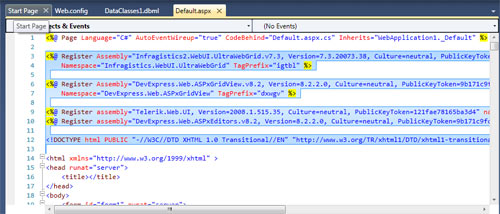

Rename the service from Service1 to MyNewService.
#Visual studio example code code#
It includes much of the basic service code, such as the code to start the service. The project template includes a component class named Service1 that inherits from. The Design tab appears ( Service1.cs or Service1.vb ). NET desktop development workload using Visual Studio Installer.įor Name, enter MyNewService, and then select OK.
#Visual studio example code install#
Return text for an incorrect option entry.Īlso add a new Program class, as follows: class ProgramĬonsole.If you don't see the Windows Service template, you may need to install the. Ask the user to enter a non-zero divisor. Public static double DoOperation(double num1, double num2, string op)ĭouble result = double.NaN // Default value is "not-a-number" if an operation, such as division, could result in an error. In Program.cs, delete everything and add the following new Calculator class: class Calculator The Calculator class handles the bulk of the calculation work, and the Program class handles the user interface and error-handling work. Rather than rely on the program class to handle all the code, you can divide your app into two classes: Calculator and Program. To prevent this exception, you can refactor the code you've previously entered. Visual Studio shows you what's wrong in the code editor. If you enter an alphabetic character when the app expects a numeric character, the app freezes. Now, when you divide any number by zero, the app asks for another number, and keeps asking until you provide a nonzero number. Use a switch statement to do the math.Ĭonsole.WriteLine($"Your result: = " + (num1 / num2)) Īfter you replace the code, the section with the switch statement should look similar to the following screenshot: Num2 = Convert.ToInt32(Console.ReadLine()) Ĭonsole.WriteLine("Choose an option from the following list:") Ask the user to type the second number.Ĭonsole.WriteLine("Type another number, and then press Enter") Num1 = Convert.ToInt32(Console.ReadLine()) Ask the user to type the first number.Ĭonsole.WriteLine("Type a number, and then press Enter") Display title as the C# console calculator app.Ĭonsole.WriteLine("Console Calculator in C#\r") Ĭonsole.WriteLine("-\n") Declare variables and then initialize to zero. In the code editor, replace all the code in Program.cs with the following new code: using System When you run the app, the result changes accordingly.Ĭontinue by adding a more complex set of calculator code to your project. For example, you can change the + operator in the int c = a + b line of code to - for subtraction, * for multiplication, or / for division. Optionally, you can change the operator to change the result. To build and run your app, press F5, or select the green arrow next to the name Calculator in the top toolbar.Ī console window opens that shows the sum of 42 + 119, which is 161. If you type the code, the Visual Studio IntelliSense feature offers you the option to autocomplete the entry. Replace the line with the following code: int a = 42 In the code editor, replace the default "Hello World" code that says Console.WriteLine("Hello World!"). In Solution Explorer, in the right pane, select Program.cs to display the file in the code editor Press any key to close the console window. After the application runs in the debugger, the console window stays open. If you press F5, you can run the default program in Debug mode. The default "Hello World" code calls the WriteLine method to display the literal string "Hello, World!" in the console window. To view it in the editor, select the code file Program.cs in the Solution Explorer window, which is typically on the right-hand side of Visual Studio.

Visual Studio opens your new project, which includes default "Hello World" code. NET Core 3.1 should already be selected for your target framework.

In the Configure your new project window, type or enter Calculator in the Project name box.

Then, return to step 2 in this " Create a project" procedure. Next, choose Continue to install the workload. You might be prompted to save your work if so, do so. NET Core cross-platform development workload.Īfter that, choose the Modify button in the Visual Studio Installer. Then, in the Visual Studio Installer, choose the. If you don't see the Console Application template, select Install more tools and features.


 0 kommentar(er)
0 kommentar(er)
